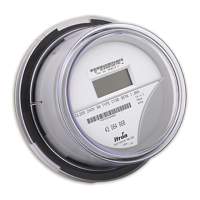Operation: C12.19 C1SD, C1ST, and C1SL Versions
42 CENTRON® Meter Technical Reference Guide
Features
Features of these multifunction modules include:
Non-Volatile Memory—Programming, register, and load profile data are stored in the
EEPROM during a power outage. Meters with timekeeping functionality contain a
battery, soldered to the circuit board, which maintains the clock circuitry during a power
outage.
Optical Port Communication—The optical port is a communication interface from
the meter to a PC. Communication through the optical port may be from 9600 (default)
to 28,800 baud.
Self-Read Capability—Billing data can be stored automatically at programmable times
to be read later. All meters are equipped with two self read (snapshot) registers;
however, meters with timekeeping functionality are allotted up to twelve self read
registers.
Load Profile—The C1SL module provides 144K RAM for up to eight channels of load
profile interval data.
Expansion Capability—An expansion port is available for future functionality (except
non-RF versions).
Bidirectional Metering—All three multifunction versions are capable of measuring
and displaying forward and reverse energy only (kWh). These modules have four
registers. The modules are capable of measuring four types of energy: delivered,
received, net, and uni-directional.
The C12.19 C1SD/T/L modules are available with an LCD display and a polycarbonate
cover. The cover contains the optical port adapter and demand reset button.
Type Codes
The type code indicates the metrology, version, base, functionality, and RF options in the
meter. The type code is found on the nameplate of the meter. The following is a depiction of
how type codes are displayed for the C12.19 D/T/L meter:
1
st
Version
C 1 S T R2
Metrology Version Base Functionality RF Option+
+
+
+
C = Singlephase
CN = Network
Socket
D = Demand
T = TOU
L = Load Profile
R2 = 2 ERT
R3 = 3 ERT
The example above is a type code for a C12.19 TOU meter with RF capability transmitting
2 ERTs.

